The fieldbus is a digital, two-way transmission, multi-branch communication network applied to the production site, connecting intelligent field devices and automated measurement and control systems.
Located at the bottom of the production control site and network structure
ï¶ Fieldbus is a low bandwidth control networkï¶
It is connected to the upper Internet and intranet intranet.
ï¶ constitutes a comprehensive communication network platform for enterprises
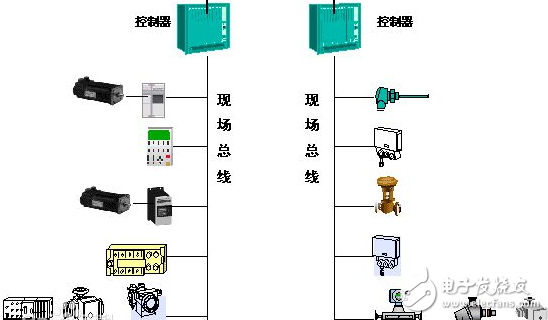
Fieldbus control system
Its software is an important part of the system. The software of the control system includes configuration software, maintenance software, simulation software, equipment software and monitoring software. First choose to develop the configuration software, control the operating human interface software MMI. Through the configuration software, the connection between the function blocks is completed, the function block parameters are selected, and the network configuration is performed. During the operation of the network, the system collects data in real time, performs data processing and calculation. Optimize control and logic to control alarms, monitors, displays, reports, and more.
2. Fieldbus measurement system
It is characterized by multi-variable high-performance measurement, which makes the measuring instrument have more functions such as computing power. Because of the digital signal, it has high resolution, high accuracy, anti-interference and anti-distortion ability, and also has the status of instrumentation equipment. Information, you can adjust the process.
3. Equipment Management System
It can provide diagnostic information, management information, equipment operating status information (including smart meters) and equipment manufacturing information provided by the manufacturer.
4. Bus system computer service module
The client/server model is currently the more popular network computer service model. The server represents the data source (provider) and the application client represents the data consumer, which takes the data from the data source and processes it further. The room machine runs on a PC or workstation. The server runs on a minicomputer or mainframe, and it uses both intelligence, resources, and data to complete the task.
5. Database
It can organize and dynamically store a large amount of data and applications, achieve full sharing and cross-access of data, and is highly independent. The parameters of industrial equipment change continuously during operation, the amount of data is large, and the real-time requirements of operation and control are very high. Therefore, a system that can communicate with each other and distribute real-time data is formed.
6. Network system hardware and software
Network system hardware: system management host, server, gateway, protocol converter, hub, user computer, etc.
Network system software: NetWarc, LAN Mangger, Vines
Server operating software: Lenix, os/2, windowNT, database, communication protocol, network management protocol, etc.
Bus classificationAt present, there are more than forty kinds of fieldbuses in the world. These fieldbuses are mostly used in process automation, medicine, processing, transportation, defense, aerospace, agriculture and buildings. The current industrial bus network can be classified into three. Class: 485 network, HART network, FieldBUS field bus network.
485 network: RS485/MODBUS is a popular industrial networking mode, which is characterized by simple and convenient implementation, and now there are many instruments supporting RS485. Now the instrument manufacturers have turned to support RS485/MODBUS for the simple reason that the RS485 conversion interface is not only cheap but also a wide variety. At least in the low-end market, RS485/MODBUS will remain the most important industrial networking method.
HART Network: HART is an excessive bus standard proposed by Emerson. The main feature is that the digital signal is superimposed on the 4-20 mA current signal, but the protocol is not really open. To join his foundation, the agreement can be obtained. And joining the foundation requires a certain fee. HART technology is mainly monopolized by several large foreign companies. In recent years, there are also companies in China, but they have not yet reached the level of foreign companies. There are now many smart meters with [HART round card] that support HART communication. However, from the domestic situation, we have not really used this part of the function to monitor the device network. At most, we only use the handheld device to set parameters. In the long run, due to the low HART communication rate and difficult networking, the application of HART instruments will decline.
FieldBus Fieldbus Network: Fieldbus is one of the hotspot technologies in today's automation field, and is known as the computer LAN in the field of automation. Its emergence marks the beginning of a new era of automation control technology. The fieldbus is a network that connects digital, serial, and multi-station communication devices that control the field and control devices in the control room. Its key symbol is to support two-way, multi-node, bus-based all-digital communication. In recent years, fieldbus technology has become a hotspot in the development of automation and instrumentation in the world. Its emergence has revolutionized the structure of traditional control systems, making the automatic control system "smart, digital, information, networked, and dispersed." In the direction of further development, a new distributed control system for network communication, Fieldbus Control System (FCS), is formed. However, so far, fieldbus has not formed a truly unified standard, ProfiBus, CANbus, CC-Link and other standards exist in parallel, and have their own living space. When is the reunification, nowhere in sight. At present, the types of instruments supporting the field bus are still relatively small, the room for selection is small, the price is high, and the amount is small.
Features and disadvantages1. Features
The field control device has a communication function to facilitate the construction of the plant's underlying control network.
The openness and consistency of communication standards make the system open and interoperable between devices.
The normalization of function blocks and structures makes interchangeability between devices of the same function.
The control function is placed on the site to make the control system structure highly dispersible.
2. Advantages
Fieldbus enables self-control devices and systems to enter the information network industry and open up a wider field for their applications;
A bunch of twisted pairs can be connected to more control equipment, which is convenient to save installation costs;
Save maintenance overhead;
Improve the reliability of the system;
Provide users with more flexible system integration initiative.
3. disadvantages
The transmission delay of data packets in network communication, the transient error of the communication system and the loss of data packets, the inconsistency between the transmission and the arrival order, etc. will destroy the original certainty of the traditional control system, making the analysis and synthesis of the control system more complicated. The performance of the control system is negatively affected.
What is Industrial Ethernet?Industrial Ethernet refers to technical compatibility with commercial Ethernet, but in the product design, in the real-time, reliability, environmental adaptability and other aspects to meet the needs of the industrial site, is developed after the field bus, the most recognized and most An industrial communication network with promising prospects.
The essence of industrial Ethernet is Ethernet technology office automation to industrial automation.
Comparison of Industrial Ethernet and Traditional Ethernet Networks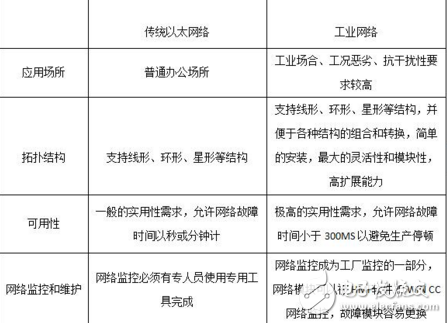
1. The high temperature, humidity, air pollution and corrosive gases in industrial production environments require industrial grade products to have climatic environmental adaptability and require corrosion resistance, dust resistance and water resistance.
2. The presence of dust, flammable, explosive and toxic gases at industrial production sites requires explosion-proof measures to ensure safe production.
3. The vibration and electromagnetic interference of the industrial production site are large, and the industrial control network must have mechanical environment adaptability (such as vibration resistance, impact resistance), electromagnetic environment adaptability or electromagnetic compatibility (EMC).
4. The power supply of industrial network devices is usually based on the low-voltage DC power supply standard in the cabinet. In most industrial environments, the required power supply in the control cabinet is low-voltage 24V DC.
5. It is installed by standard rails and is easy to install. It is suitable for industrial environment installation. Industrial network devices should be easily installed in industrial field control cabinets and easily replaced.
Main standardIndustrial Ethernet is developing the appropriate application layer and user layer protocols according to the requirements of industrial control, enabling Ethernet and TCP/IP technologies to be applied to the control layer and extending to the field layer. In the information layer, IT industry is used as much as possible. Effective and up-to-date results, therefore, the application of Industrial Ethernet and Ethernet in the industry is not the same concept.
1. IDA communication structure and communication protocol
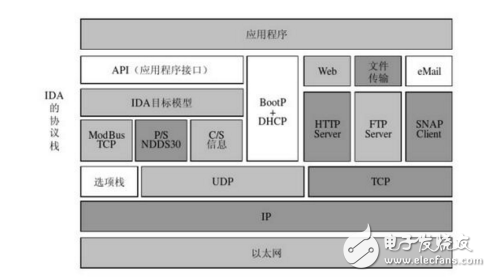
DA is an industrial Ethernet specification based entirely on Ethernet. It combines a real-time WEB-based distributed automation environment with a centralized security architecture. The goal is to create a solution for distributed automation based on TCP/IP. Program.
2.Ethernet/IP communication structure and communication protocol
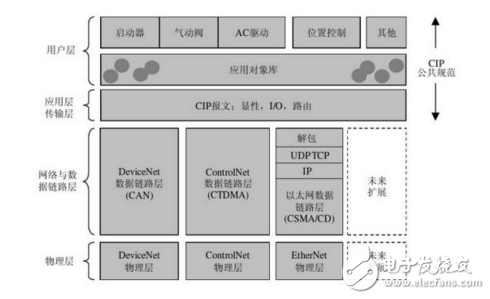
In addition to DviceNET and ControlNet, ODVA also controls another bus, EtherNet/IP, which bundles the TargetNet and ControlNet target libraries CIP (including all classic PLC operations) at the application and user layers with Ethernet physical media. .
3.PROFlnet communication structure and communication protocol
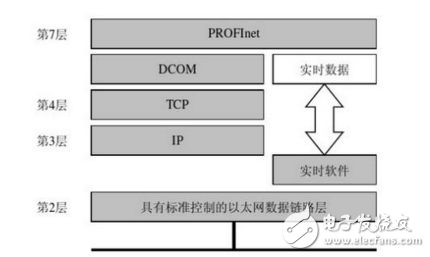
As shown in the figure, its data link layer adopts a transmission protocol designed to reduce the time required to process the communication stack, thereby greatly shortening the network refresh time and ensuring that the refresh time is 5~10MS. In addition to cyclic transmission, the real-time channel can also perform acyclic (event trigger, process data modification, operation command release, etc.) transmission. Also add network management, WEB capabilities, and direct integration of I / O devices.
4.HSE communication structure and communication protocol
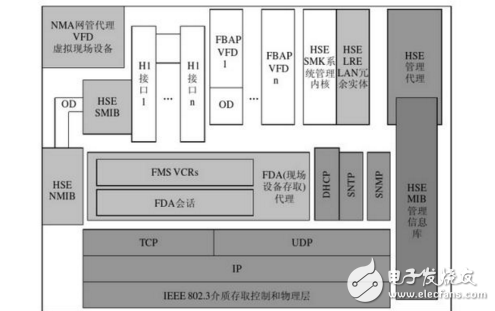
The FF (Fieldbus Foundation) in the United States uses the FCS system developed by high-speed Ethernet to control the backbone of the communication network above the control level. The H1 field bus is still used below the control level to form an information integration open architecture. The HSE follows the standard Ethernet specification. . FF specifies 21 functional blocks in the specification to be used for basic process control and advanced process control. These standard function blocks reside in field devices connected to the HSE and are linked as long as they are configured. For complex batch and hybrid control applications, FF also specifies flexible function blocks that support data acquisition monitoring, subsystem interfaces, event sequencing, multi-channel data acquisition, and can be used as a network for communication with PLCs and other protocols. Interconnectors, so we can conclude that HSE Industrial Ethernet provides a variety of solutions for continuous real-time control required by continuous process control industries and intermittent manufacturing. It is a continuous process control system. Intermittent manufacturing control systems, batch control systems, and integration of enterprise information management systems such as MES and ERP provide a fairly mature standard protocol for industrial Ethernet.
Problems to be solved in industrial controlIndustrial Ethernet is generally technically compatible with commercial Ethernet, but it is a typical industrial communication network when it is designed to meet the needs of industrial sites in terms of real-time, reliability, and environmental adaptability. Compared to commercial Ethernet, Industrial Ethernet has special requirements in the following areas:
1. Requires high real-time and good time certainty
2. The transmission information is mostly short frame information, and the information exchange is frequent.
3. Strong fault tolerance, reliability and security
4. Control network structure is highly dispersive
5. Control network protocol is simple and practical, and work efficiency is high
6. Autonomy of control equipment and autonomy of control functions
7. Efficient communication with the information network, easy to integrate with the information network
8. Equipment reliability and environmental adaptability
9. Long distance transmission
10. Bus power supply
11. Network security
12. Interoperability
Advantage1. Wide range of applications
Ethernet is currently the most widely used computer network technology, receiving a wide range of technical support, the most typical Ethernet application form such as: Ethernet + TCP / IP + web. Almost all programming languages ​​support Ethernet application development.
2. Low cost
Because Ethernet is the most widely used, it has received great attention and extensive support from hardware developers and manufacturers. There are many hardware products for users to choose from, and because of the wide application, the hardware price is relatively low.
3. High communication rate
At present, Ethernet Ethernet communication speed of 10M, 100M Fast Ethernet has also begun to be widely used, 1000M Ethernet technology is also gradually mature, 10G Ethernet is also being studied, and its communication rate is much faster than the current field bus.
4. Rich in hardware and software resources
Ethernet has been used for many years. People have a lot of experience in Ethernet design and application, and they are very familiar with its technology. A large amount of software resources and design experience can significantly reduce system development and training costs, which can significantly reduce the overall cost of the system and greatly accelerate the speed of system development and promotion.
5. Strong sustainability
Due to the wide application of Ethernet, its anti-war has been widely valued and a large amount of technical input, forming a global technical support, and in the era of rapid changes in information, the survival and development of enterprises will depend heavily on one. With the rapid and effective communication network management, the development of information technology and communication technology will be more rapid and mature, thus ensuring the continuous development of Ethernet technology.
6. Easy to implement management and control integration
It is easy to realize the seamless integration of control network and information network, establish a unified enterprise network, and realize embedded controller, intelligent field measurement and control instrument and sensor, etc., to easily access the Ethernet network until it is connected to the Internet.
Ningbo Autrends International Trade Co.,Ltd. , https://www.mosvapor.com